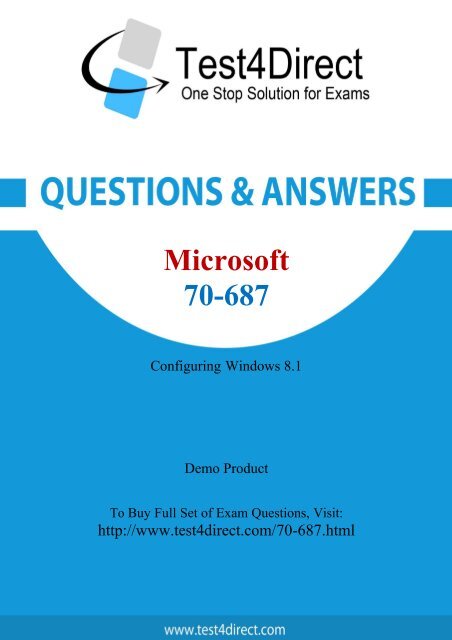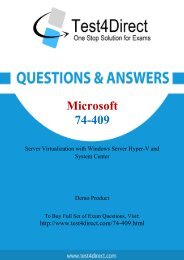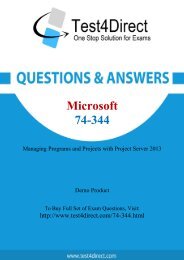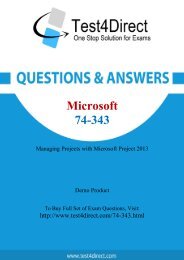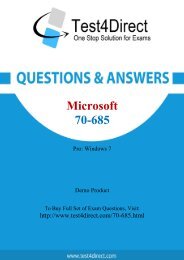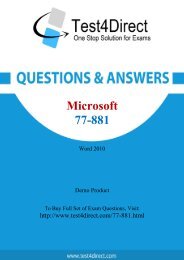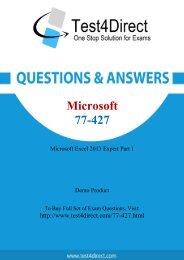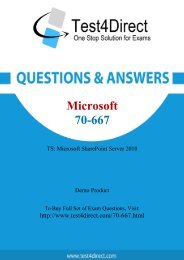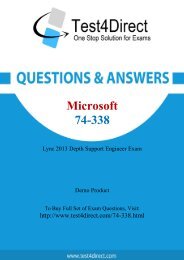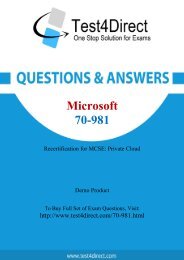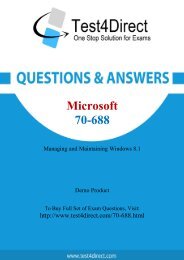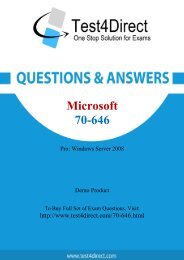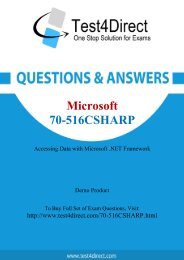70-687 BrainDumps
Test4Direct provides latest PDF questions of Microsoft 70-687 exam. You have an opportunity to pass the Microsoft 70-687 exam in one go. Test4Direct is most accurate source to prepare Microsoft 70-687 exam as your success will become site’s responsibility after purchasing 70-687 exam product. There are also lots of discounts and promotion offers that you can avail. Let’s try a free demo http://www.test4direct.com/70-687.html
Test4Direct provides latest PDF questions of Microsoft 70-687 exam. You have an opportunity to pass the Microsoft 70-687 exam in one go. Test4Direct is most accurate source to prepare Microsoft 70-687 exam as your success will become site’s responsibility after purchasing 70-687 exam product. There are also lots of discounts and promotion offers that you can avail. Let’s try a free demo http://www.test4direct.com/70-687.html
Create successful ePaper yourself
Turn your PDF publications into a flip-book with our unique Google optimized e-Paper software.
Microsoft<br />
<strong>70</strong>-<strong>687</strong><br />
Configuring Windows 8.1<br />
Demo Product<br />
To Buy Full Set of Exam Questions, Visit:<br />
http://www.test4direct.com/<strong>70</strong>-<strong>687</strong>.html
Question: 1<br />
A company has 100 client computers that run Windows 8. You need to assign static IPv6 addresses to<br />
the client computers. Which Windows Powershell cmdlet should you run?<br />
A. Set-NetTCPSetting<br />
B. Set-NetIPInterface<br />
C. Set-NetlPv6Protocol<br />
D. set-NetIPAddress<br />
Explanation:<br />
Modifies IP address configuration properties of an existing IP address<br />
Question: 2<br />
Question: 3<br />
Answer: D<br />
A company has an Active Directory Domain Services (AD DS) domain. All client computers run<br />
Windows 8. Portable client computers no longer connect to the corporate wireless network. You<br />
need to ensure that when the corporate wireless network is available, the computers always connect<br />
to it automatically. Which two actions would achieve the goal? (Each correct answer presents a<br />
complete solution. Choose two.)<br />
A. Create a Group Policy object (GPO) to configure a wireless network policy. Link the GPO to the<br />
organizational unit that contains the computers.<br />
B. Configure the corporate wireless network as an unmetered network.<br />
C. Configure the corporate wireless network as a preferred network.<br />
D. Manually connect to the corporate wireless network and select the option to connect<br />
automatically to that network.<br />
Answer: C, D<br />
A company has client computers that run Windows 8. The corporate network is configured for tPv4<br />
and IPv6. You need to disable Media Sensing for IPv6 on the client computers without affecting IPv4<br />
communications. What should you do on each client computer?<br />
A. Run the Disable-NetAdapterBinding Windows PowerShell cmdlet.<br />
B. Run the Disable-NetAdapter Windows PowerShell cmdlet.<br />
C. Run the Set-NetlPv6Protocol Windows PowerShell cmdlet.<br />
D. Run the Set-NetlPv4Protocol Windows PowerShell cmdlet.<br />
Explanation:<br />
http://technet.microsoft.com/en-us/library/hh826144.aspx<br />
Answer: C
Set-NetIPv6Protocol [-DhcpMediaSense] Modifies the DHCPMediaSense<br />
property. This parameter value provides a mechanism for the network adapter to notify the protocol<br />
stack of media connect and disconnect events. These events trigger the DHCP client to take some<br />
action, such as attempting to renew a DHCP lease or removing routes related to a disconnected<br />
network. One application of Media Sense enables the network parameters on the notebook<br />
computer of a roaming user to automatically and ransparently update without rebooting when the<br />
user moves from one location to another.<br />
The acceptable values for this parameter are:<br />
Enabled: DhcpMediaSense set to Enabled.<br />
Disabled: DhcpMediaSense is set to Disabled.<br />
The default value is Enabled<br />
Question: 4<br />
DRAG DROP<br />
A company has an Active Directory Domain Services (AD DS) domain. All client computers run<br />
Windows 8. Two computers named COMPUTER1 and COMPUTER2 are connected to one network<br />
switch and joined to the domain. Windows Firewall is turned off on both computers. You are<br />
planning a remote management solution. You have the following requirements:<br />
• Ensure that COMPUTER2 can run remote commands on COMPUTER1.<br />
• Test the solution by successfully running a command from COMPUTER2 that executes on<br />
COMPUTER1.<br />
You need to select the commands to run on COMPUTER1 and COMPUTER2 to meet the remote<br />
management requirements.<br />
Which commands should you run? (To answer, drag the appropriate command or commands to the<br />
correct location or locations in the answer area. Commands may be used once, more than once, or<br />
not at all. You may need to drag the split bar between panes or scroll to view content.)<br />
Answer:
Question: 5<br />
A company has 100 client computers that run Windows 8. The client computers are members of a<br />
workgroup. A custom application requires a Windows Firewall exception on each client computer.<br />
You need to configure the exception on the client computers without affecting existing firewall<br />
settings. Which Windows PowerShell cmdlet should you run on each client computer?<br />
A. New-NetFirewallRule<br />
B. Set-NetFirewallSetting<br />
C. Set-NetFirewallRule<br />
D. Set-NetFirewallProfile<br />
E. New-NetIPSecMainModeRule<br />
Question: 6<br />
Answer: A<br />
Explanation:<br />
Creates a new inbound or outbound firewall rule and adds the rule to the target computer.<br />
http://technet.microsoft.com/en-us/library/jj554908.aspx<br />
New-NetFirewallRule -DisplayName “Allow Inbound Telnet” -Direction Inbound -Program<br />
%SystemRoot%\System32\tlntsvr.exe -RemoteAddress LocalSubnet -Action Allow<br />
A company has an Active Directory Domain Services (AD DS) domain. All client computers run<br />
Windows 8. Portable client computers connect to the corporate wireless network. You have the<br />
following requirements:<br />
• Prevent users from configuring a wireless network by using settings from a USB flash drive.<br />
• Do not affect the use of other USB devices.<br />
You need to create a Group Policy object (GPO) to meet the requirements.<br />
Which GPO should you create?<br />
A. A GPO that disables the Allow only USB root hub connected Enhanced Storage Features policy<br />
setting.<br />
B. A GPO that enables wireless policy processing.<br />
C. A GPO that prohibits connections to mobile broadband networks when roaming.<br />
D. A GPO that configures Windows Connect Now settings.<br />
Answer: D<br />
Explanation:<br />
http://windows.microsoft.com/en-US/windows-vista/What-is-Windows-Connect-Now<br />
Computer Configuration\Policies\Administrative Templates\Network\Windows Connect Now<br />
Turn Off Ability To Configure Using A USB Flash Drive setting:<br />
Prevents Windows from being able to store a Windows Connect Now configuration to a UFD.<br />
Because the Windows Connect Now information stored on a UFD contains information that can allow<br />
computers to access your protected wireless network, you might choose to disable this setting to<br />
improve the security of your wireless networks.<br />
http://sourcedaddy.com/windows-7/windows-connect-now-in-windows-7.html
Question: 7<br />
A company has client computers that run Windows 8. The client computers are connected to a<br />
corporate private network. Users are currently unable to connect from their home computers to<br />
their work computers by using Remote Desktop. You need to ensure that users can remotely connect<br />
to their office computers by using Remote Desktop. Users must not be able to access any other<br />
corporate network resource from their home computers. Which setting should you configure on the<br />
home computers?<br />
A. Virtual Private Network connection<br />
B. Remote Desktop local resources<br />
C. DirectAccess connection<br />
D. Remote Desktop Gateway IP address<br />
Question: 8<br />
Answer: A<br />
Explanation:<br />
DirectAccess is for Windows Server 2008/2012/Win 7 Ultimate/Enterprise/Win 8 Enterprise only RD<br />
Gateway setup is only for servers Create VPN through manage networks. File --> Allow incoming<br />
connections. Connect through internet and create VPN which will allow one computer at a time to<br />
view the hosts resources, and only the hosts resources unlike standard VPNs.<br />
A company has an Active Directory Domain Services (AD DS) domain. All client computers run<br />
Windows 8. Client computers use Window BitLocker Drive Encryption with a Trusted Platform<br />
Module (TPM) chip. You need to create a Group Policy object (GPO) that will secure the TPM owner<br />
information. Which policy setting should you configure?<br />
A. Enable the Turn on TPM backup to Active Directory Domain Services policy setting.<br />
B. Enable the Configure the level of TPM usage authorization information available to the registry<br />
policy setting.<br />
C. Set the Configure the level of TPM owner authorization information available to operating system<br />
policy setting to Full.<br />
D. Enable the Configure TPM platform validation profile policy setting.<br />
Explanation:<br />
http://technet.microsoft.com/en-us/library/jj679889.aspx<br />
Answer: A
Question: 9<br />
A company has client computers that run Windows 8. The company uses Windows BitLocker Drive<br />
Encryption with the data-only option o all client computers. You delete a file containing highly<br />
confidential information from your computer. You need to clear the free space on the hard drive to<br />
minimize the chance of the confidential information being recovered. Which command should you<br />
run on the client computer?<br />
A. manage-bde –w<br />
B. chkdsk/spotfix<br />
C. diskpart clean<br />
D. BdeHdCfg -target c: shrink<br />
Question: 10<br />
Question: 11<br />
Answer: A<br />
Explanation:<br />
http://technet.microsoft.com/en-us/library/jj647761.aspx<br />
Manage-bde –WipeFreeSpace|-w [] [-Cancel] [-computername ] [{-?|/?}] [{-help|h}]<br />
manage-bde -w C:<br />
Wipes the free space on the volume removing any data fragments that may have existed in the<br />
space.<br />
You deploy several tablet PCs that run Windows 8. You need to minimize power usage when the user<br />
presses the sleep button. What should you do?<br />
A. Configure the active power plan to disable Wake Timers.<br />
B. Configure the active power plan to use Fast Startup.<br />
C. In Power Options, configure the sleep button setting to Hibernate.<br />
D. In Power Options, configure the sleep button setting to Sleep.<br />
Answer: C<br />
A company has an Active Directory Domain Services (AD DS) domain. All client computers run<br />
Windows 8 and are joined to the domain. You have the following requirements:<br />
• Ensure that files in shared network folders are available offline.<br />
• Maximize efficiency for users who connect to shared network folders from a mobile device.<br />
You need to configure Group Policy settings to meet the requirements.<br />
What should you do first?<br />
A. Enable and configure the Configure slow-link mode policy setting.<br />
B. Enable the Enable file synchronization on costed networks policy setting.<br />
C. Enable the Synchronize all offline files when logging on policy setting.<br />
D. Enable and configure the Specify administratively assigned Offline Files policy setting.<br />
Answer: B
Explanation:<br />
Question: 12<br />
You install Windows 8 on a desktop computer. You create a system image and then install third-party<br />
desktop apps and create personal data. You disable the creation of restore points. The computer is<br />
not running optimally. You need to remove the third-party applications and preserve files that are<br />
stored in your Documents folder. You start the computer from a system repair disk. Which<br />
troubleshooting option should you use?<br />
A. Refresh your PC without affecting your files<br />
B. System Restore<br />
C. Remove everything and install Windows<br />
D. System Image Recovery<br />
Answer: A
Explanation:<br />
Basically the Refresh feature allows you to refresh your Windows 8 installation back to a vanilla,<br />
brand new install while preserving all your personal files. Windows 8 also includes a Reset feature<br />
which is similar however resetting your install deletes all personal files so don’t select this unless you<br />
want a full system wipe.<br />
This is what happens:<br />
Your files and personalization settings won't change.<br />
Your PC settings will be changed back to their defaults.<br />
Metro-style apps from the Windows store will be retained.<br />
Question: 13<br />
A company has client computers that run Windows 8. File History is on. An employee downloads<br />
data to a folder on drive D named Archives. You need to ensure that the user can restore files from<br />
the Archives folder by using File History. What should you do?<br />
A. Configure the File History advanced settings to include the Archives folder.<br />
B. From the File History configuration options, change the drive and select the Archives folder.<br />
C. Create a library named History and add the Archives folder to the library.<br />
D. Move the Archives folder into the Windows system folder.<br />
Question: 14<br />
Answer: C<br />
Explanation:<br />
http://blogs.msdn.com/b/b8/archive/2012/07/10/protecting -user-files-with-file-history.aspx<br />
File History only backs up data in libraries, favorites, desktop, and contacts and must use a nonsystem<br />
drive for backup.<br />
You have a portable computer that runs Windows 8. You are creating a backup plan.<br />
You have the following requirements:<br />
• Automatically back up the files in your Documents folder every hour.<br />
• Ensure that you can recover different versions of the backed-up files.<br />
• Do not back up the Windows operating system files.<br />
You need to configure the computer to meet the requirements.<br />
Which two actions should you perform? (Each correct answer presents part of the solution. Choose<br />
two.)<br />
A. Create a volume mount point in your Documents folder.<br />
B. Connect an external hard drive to the computer.<br />
C. Schedule a task to create a restore point every hour.<br />
D. Create a recovery drive on drive C.<br />
E. Turn on File History.<br />
Answer: B, E<br />
Explanation:<br />
File History only backs up data in libraries, favorites, desktop, and contacts and must use a non-
system drive for backup.<br />
Question: 15<br />
A company has client computers that run Windows 8. You install a new device on a client computer.<br />
The device installation includes an application that runs when the computer starts. You experience<br />
problems with the application. You need to prevent the application from running when the computer<br />
starts, without affecting any other application. What should you do?<br />
A. Configure the application by using Task Manager.<br />
B. Run the bcdedit command.<br />
C. Configure the device by using Device Manager.<br />
D. Run the msconuig command.<br />
Explanation:<br />
It’s a new feature of Windows 8<br />
http://pcworld.co.nz/pcworld/pcw.nsf/feature/20-essential-windows-8-tips-and-tricks<br />
Answer: A
THANKS FOR TRYING THE DEMO OF OUR PRODUCT<br />
Visit Our Site to Purchase the Full Set of Actual <strong>70</strong>-<strong>687</strong> Exam Questions With Answers.<br />
http://www.test4direct.com/<strong>70</strong>-<strong>687</strong>.html<br />
We Also Provide Practice Exam Software That Simulates Real Exam Environment And Has<br />
Many Self-Assessment Features. Download Free Product Demo From:<br />
http://www.test4direct.com/<strong>70</strong>-<strong>687</strong>.html<br />
Money Back Guarantee<br />
Check Out Our Customer Testimonials


